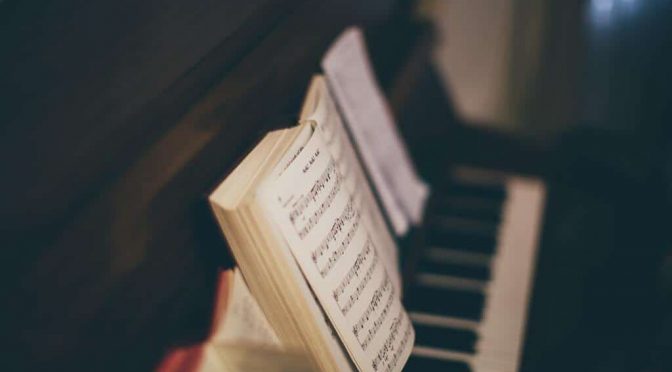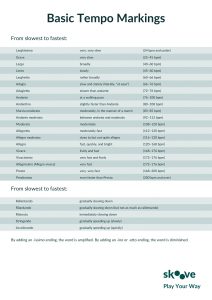Piano Blog by Skoove – Piano Practice Tips
Have you ever looked at a piece of music and wondered what all the Italian words at the top are supposed to mean? Words like allegro or andante or maybe even vivace? Have you seen this written on a metronome before? These words are all terms for tempo. Read on to learn more about the wonderful world of tempo markings in music!
What is tempo?
What is tempo? Tempo is the word musicians use to describe the speed of the music. A faster tempo in music means a faster speed, while a slower tempo means a slower speed. There are many music terms for tempo, many of which we will learn here. Most frequently, we use Italian tempo markings, but there are markings for tempo in other languages as well.
Why is tempo important
Tempo in music is important because, without understanding tempo, we would have no idea what speed to play a particular piece of music. For example, the intro to“Bohemian Rhapsody” is performed in a slow and dramatic style. This piece would sound completely different and lose its contrasting and dynamic character if the intro was performed quickly. Without understanding how tempo works in music, we would not grasp this important point, and consequently, lose out on some of the most powerful and dynamic aspects of music!
Music tempo markings
There are many different tempo markings in music. We will learn about the most common music terms for tempo first. Most of these Italian tempo markings can be found on the online metronome and can also be found at the beginning of any piece of music above the key signature on the top left side. Here are some common examples of music tempo markings:
-
Grave
Grave (GRAH-vay) is a very slow and solemn tempo between 25-45 beats per minute (bpm). Here is an example of grave in music:
-
Lento/Largo
Lento and largo are two music terms for tempo that mean slowly. Largo is generally thought of as more “broadly” while lento is more “slow”, but they are often used interchangeably to mean a speed between 40-60 bpm. Here is an example of largo in music:
-
Adagio
Adagio literally means “at ease.” Adagio is a tempo marking in music that means gentle and easy and is not too slow or too fast. Adagio generally falls between 66-76 bpm. Here is an example of adagio:
-
Andante
The term andante means walking speed or a walking pace. Andante is a tempo between 76 and 108 bpm. Here is an example of andante in music:
-
Moderato
Moderato means moderately and is associated with speeds from 108-120 bpm on the metronome. Here is an example of moderato in music:
-
Allegro
Allegro is thought of as fast, quick, and bright. Think of a sparrow flying in spring or a rock skipping across to water. Allegro includes a wider range on the metronome than the other Italian tempo markings so far. Generally tempos from 120-168 bpm are considered allegro. Here is an example of allegro in music:
-
Vivace
Vivace is a step above allegro. Vivace is also light and fast, ranging from 168-176 bpm on the metronome. Have you ever seen a cafe called something like “Vivace” or “Espresso Vivace”? That sort of zippy, caffeinated feeling accurately captures the tempo of vivace. Here is an example of vivace in music:
-
Presto
The finally Italian tempo marking we will dive into here is called presto. Presto is extremely fast and light. Anything above 170 bpm can be called presto. Having proper piano technique is critical to playing comfortably at presto. Check out this example of presto from the famous “Flight of the Bumblebee”:
More important terminology
Now that you have a basic grasp of the music tempo markings, there are a few smaller details that need to be addressed. Many of these music tempo terms cover a wide range on the metronome. For example, the range of allegro is about 40 bpm. What is different about an allegro at 120 versus an allegro at 160? How do you differentiate the two tempos?
To differentiate tempos, we often add a few different suffixes or combine two terms together to create a hybrid tempo. The suffixes we add are –issimo, -ino, and –etto.
The suffix -issimo amplifies tempo in music. For example, prestissimo is very, very fast, even faster than presto. Vivacissimo and allegrissimo or both at the faster ends of vivace and allegro, generally 172-176 bpm. Larghissimo is very slow, like a glacier melting or the sands of time-shifting in a forgotten desert.
The suffixes –ino and -etto diminish a marking. For example, allegretto is a way to describe the slower end of allegro, or tempos that are within 10 bpm of 120 bpm, and larghetto is slightly faster than largo, around 60-66 bpm.
At other times, two music tempo terms are combined to form hybrid marking that captures and combines the essences of the two. An example of this is allegro vivace, meaning fast and light around 176 bpm. Andante moderato or allegro moderato are other examples of this hybrid approach. By using these suffixes or hybridizations of tempo markings, we can cover more territory and learn to be more descriptive of our own music-making!
Why all the Italian?
At this point, you might be wondering why all these music terms for tempo are all in Italian. After all, what does a word like vivace or largo really mean? You could just as easily say something like “quick and bright” or “slow and long” to describe the same moods, right?
While technically you would be correct, it is important to understand a little bit of the history. Tempo indications as we understand them now, first appeared in the Baroque and early Classical periods. Most pieces of music were given titles based on the tempo of the piece.
Titles were also given based upon the type of dance that a piece was composed for, or for the musical mode of the piece. Italian is used primarily because Italy was an early hub of music during the Renaissance and Baroque periods, but as composers from other regions gained popularity, tempo markings in French, German, and English gained usage as well. Today, you will find music tempo terms in all languages and with many more variations beyond the basic Italian tempo markings, we covered here.
What about tempo changes?
How do we describe changing tempos in music? If a song begins adagio, then speeds up to allegro, and ends largo, how will we know this is happening? How can we write this in our own music? Here are the main terms used for speeding up or slowing down tempo:
- Rallentando – slowing down. Often abbreviated rall.
- Ritardando – slowing down, but not as pronounced as rallentando. Often abbreviated as rit.
- Ritenuto – immediately slowing down. Ritenuto can be abbreviated as rit. or riten.
- Accelerando – speeding up. Often abbreviated accel.
Conclusion
Hopefully now you have an adequate answer to the question of what is tempo? Tempo is how musicians refer to the speed and often the feeling of a particular piece of music. Traditionally, tempo markings in music are given in Italian, but they are also common in French, German, English, and just about every other language.
Originally, tempo markings were given as the title of a piece or to indicate a particular dance style, but as music progressed into newer venues, the usage of tempo terms also expanded. Feel free to practice writing tempo markings on blank sheet music and give it to your friends to try out. Understanding how tempo markings work will deepen your knowledge of music and enhance your abilities as a performer and listener of music!
Skoove is here to help you on your journey to learn all the hidden mysteries of music! There are many terms in music that can be difficult to understand, but with Skoove’s online piano lessons, learning music is fun and easy.
Try out a free, 7-day trial today! You will be surprised at how the tempo flies!
Author of this blog post

Eddie Bond is a multi-instrumentalist performer, composer, and music instructor currently based in Seattle, Washington USA. He has performed extensively in the US, Canada, Argentina, and China, released over 40 albums, and has over a decade experience working with music students of all ages and ability levels.
Read More
This article is from an external source and may contain external links not controlled by Empeda Music.


